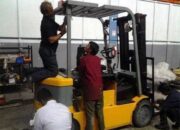Comparison between Buying and Renting Container Forklifts
1. Benefits of Buying a Container Forklift compared to Renting
– Lower initial cost: When buying a container forklift, the initial cost will be lower compared to renting. Users only need to make a one-time payment and own the container forklift.
– No time limitation on usage: When buying a forklift, users are not limited by time. They can use the container forklift for as long as necessary without worrying about returning it after a certain period.
– Decision-making power for upgrades and repairs: When buying a forklift, users have the freedom to decide on upgrades or repairs according to their needs and preferences.
– Depreciation of assets for tax reduction: Buying a container forklift allows users to depreciate the asset for tax reduction, helping save costs in business operations.
2. Benefits of Renting a Container Forklift compared to Buying
– No large upfront investment: When renting a container forklift, users do not need to make a large upfront investment like when buying. Instead, they only need to pay monthly or yearly rental fees.
– Reduced risk when business models change: Renting a container forklift helps reduce risks when business models change. If there is a need to change scale or type of business, users can easily switch to using the appropriate type of forklift without financial difficulties.
– Reduced regular maintenance costs: When renting, users do not have to worry about regular maintenance and servicing of the forklift. These costs will be covered by the rental company.
– Always using the latest forklift technology: When renting, users always have access to the latest and most advanced container forklifts in the market. This helps increase work efficiency and reduces the risk of breakdowns.
3. Comparison of cost factors between both options
– Initial purchase/rental cost: When buying, users have to pay a large upfront amount to own the container forklift, while renting only requires a small rental fee or deposit.
– Fuel costs: Both options have fuel costs for operating the container forklift. However, these costs may vary depending on the type of forklift and level of usage.
– Regular maintenance costs: When owning a forklift, users have to bear the regular maintenance and servicing costs. On the other hand, when renting, these costs are covered by the rental company.
– Insurance costs: When owning a forklift, users need to purchase insurance for the vehicle and driver. When renting, the rental company already has insurance coverage for their fleet.
– Replacement parts costs: When owning a forklift, users have to provide and pay for replacement parts when necessary. When renting, the rental company takes responsibility for this.
4. Analysis of factors when making a decision to buy or rent a container forklift
– Usage needs: Users need to consider their long-term or short-term usage needs of the container forklift to decide whether to buy or rent.
– Available budget: Users need to consider their current budget to decide whether they have enough funds to buy or only rent a forklift.
– Long/short-term business strategy: Users need to consider their long-term or short-term business strategy to decide whether buying or renting is more suitable for their container forklift needs.
Trusted Sales and Rental Address of Container Forklifts in Binh Duong
Are you in need of renting or buying a container forklift in Binh Duong but unsure of any reputable and quality addresses? Let Samcovina Joint Stock Company help you!
Samcovina currently has a diverse range of container forklifts in various types and models. Customers can choose from electric-powered, diesel-powered, or pneumatic-powered forklifts that suit their job requirements. Our experienced team of technicians is always ready to advise and support customers in the selection process.
In addition, Samcovina provides competitive rental services for container forklifts. Customers can rent on a daily, weekly, or monthly basis, offering flexibility and cost savings. We guarantee the quality and safety of the container forklifts for each customer.
Moreover, Samcovina offers maintenance and repair services for container forklifts. Our professional team of technicians is ready to assist with any related issues. We use genuine replacement parts and adhere to strict inspection procedures to ensure the quality of our work.
With the goal of customer satisfaction, Samcovina not only provides sales and rental services for container forklifts but also supports customers in choosing the most suitable type of forklift.
Contact Samcovina today for consultation and detailed pricing.
SAMCOVINA JOINT STOCK COMPANY
Tax Code: 0313121108
Address: No. 3 Street 1, Song Than Industrial Zone, Di An Ward, Di An City, Binh Duong Province, Vietnam
Email: info@samcovina.com







